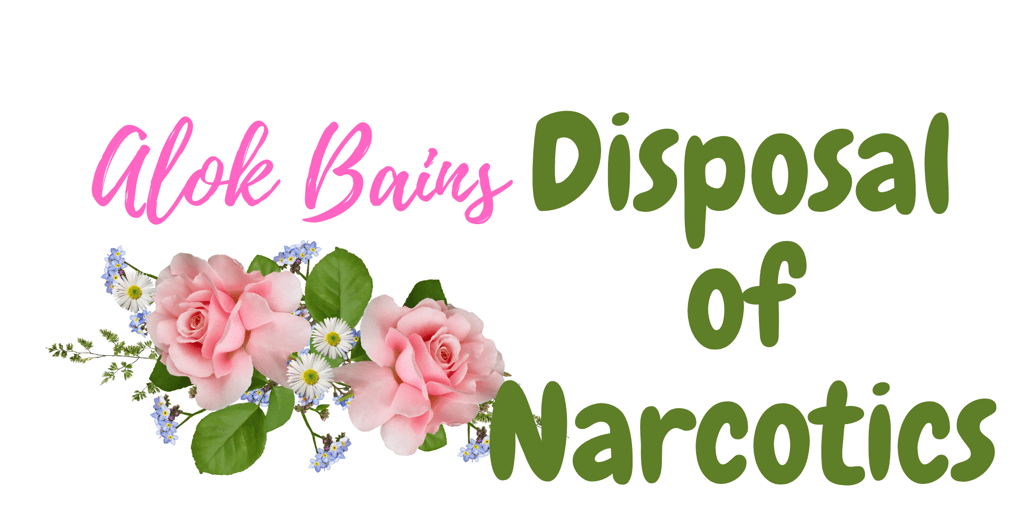Narcotic Disposal
Disposal of Narcotics
HOSPITAL PHARMACY
Alok Bains
4/26/20234 min read


Disposal of Narcotics
Compiled by Alok Bains
Article 47 of the constitution of India has made it mandatory for the states to prohibit the consumption of narcotics and psychotropic substances consumption except for medicinal purposes. In India, Narcotics are regulated by the Narcotic and Psychotropic Act 1985 and Drugs and Cosmetics Act 1940 and Rules 1945. The disposal of narcotics under the Narcotic and Psychotropic Act 1985 mainly regulates confiscated illicit narcotics. Drugs and Cosmetics Rules 1945 include narcotics under Schedule X.
Schedule X of the Drug and cosmetic rules 1945 deals with drugs based on narcotics. Any stereoisomeric form of the substance specified in Schedule X, any salts of these substances, and preparation containing such substances are also covered by this Schedule X.
Schedule X drugs are habit-forming, with abuse, trafficking and addiction properties. These medicines are mainly used for the treatment of chronic pain, anxiety, hyperactivity disorder, etc. They cause delusion, hallucination, psychosis, sedation and hypnosis.
Schedule X drugs are highly reregulated that have to observe additional conditions in addition to mentioned conditions in Schedule H drugS of the Drug and cosmetic rules 1945. The use and disposal of Schedule X drugs require a high level of supervision. Hospitals mainly deal with narcotics under Schedule X of the Drug and Cosmetic Rules 1945.
Here disposal of narcotics under Schedule X shall be discussed. The disposal of narcotics under Narcotics is regulated by the Narcotic and Psychotropic Act 1985 and shall not be discussed.
Disposal of Schedule X drugs:
Drug and Cosmetic Acts and Rules do not have any specific criteria regarding the disposal of Schedule X drugs. But it states these drugs should be handled under the direct supervision of the pharmacist which includes receiving, storage, dispensing and disposal. Before dispensing and disposal these drugs shall be stored under lock and key reserved for storage of schedule X drugs only. Storage area for schedule X drugs should be separated from another area of the premises. Only responsible and authorized persons will have access to this area. Pharmacists shall maintain all records related to Schedule X in a separate register. There shall be a separate page for each Schedule X drug under the hospital.
As there are no fixed criteria for their disposal, their disposal procedure shall be the same as expired drugs. Drugs and Cosmetic Act and Rules are silent about unused Schedule X drugs in patients' possession or in the ward of the hospital.
Procedure for disposal of Schedule X drugs in the event of cancellation of license.
The pharmacist shall apply in writing to the licensing authority for disposal of Schedule X drugs under his/her possession with the following details
The license number for sale/ manufacturing.
Name and address of the person to whom drugs are proposed to be sold or supplied.
Name of the drug and their quantity, batch number.
Name and address of the manufacturer,
Date of expiry,
Licensing authority after examining the details may instruct the inspector to inspect the premises where drugs are stocked. After complete verification licensing authority grant permission for the disposal of the drugs.
Even United States (US) does not have uniform regulations to dispose of unused narcotics by the patient or in the hospital.
US FDA recommends flushing them in the toilet and including them in the “Flush List”.
The US Environmental protection agency (EPA) does not recommend this practice to avoid groundwater contamination. Manufacturers advise end users to flush it as they are regulated by the FDA. Hospitals do not advise so as they are regulated by the EPA. But here FDA procedures to dispose of narcotics shall be discussed. The US Drug enforcement agency has its guidelines to dispose of narcotics.
US DEA (Drug Enforcement Agency) guidelines:
It establishes a DEA collection site (centre) for narcotics. Anyone can find their location and collection day through phone calls. Pharmacy and hospitals also set up collection centres. Pharmacy and hospitals can only take back narcotics if they have collection centres. Narcotics can also be mailed to DEA in a specific container. DEA also establishes a drop box for narcotics. Thus narcotics can be disposed of by following modes
DEA (Drug Enforcement Agency) collection centre,
Approved hospital and pharmacy,
Mail back system,
Dropbox.
Manufacturers also insert leaflets to dispose of leftover narcotics. It may state the following
Flush the narcotics: Flush them in the toilet or pour them into the sink. If they are capsules or tablets crush them, break them then flush them or pour them into the sink. If they are lozenges cut them and flush them, do not flush more than 5 lozenges at one time. Dissolve the lozenges in hot water and pour them into the sink. If it is a patch, zip it and flush it.
Put narcotics in the trash: Scratch out information from the label of narcotics. Put it in the trash. Do not put any information about narcotics. It should look like normal trash. Keep the trash out of children rich and animals rich. If it is a tablet or capsule, pack it in a plastic bag or plastic container with a lid and add dirt, sawdust, used coffee grounds or similar materials inside the container. Seal it and through it or put it in the trash. If it is a patch and cannot flush it, put it in a bag or container and flush it. If it is a lozenge and cannot flush, put it in its container, put the container in any other bag and put it in the trash.
Nursing home: Talk to officials in a nursing home. They have the knowledge and they will guide.
Compiled by Alok Bains
